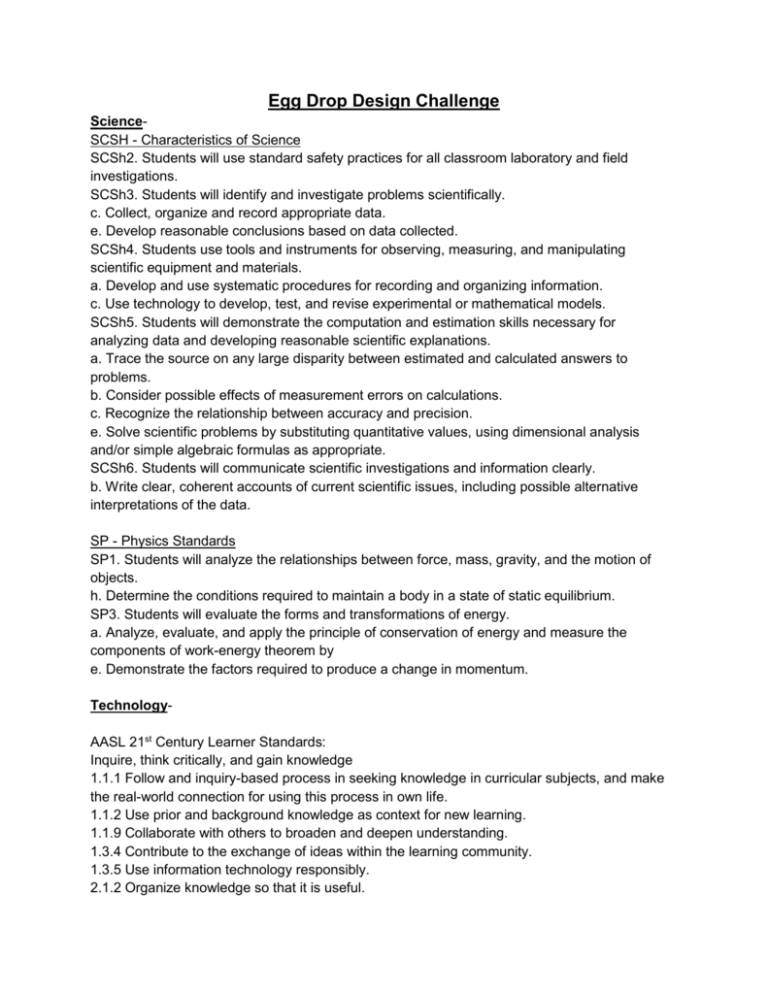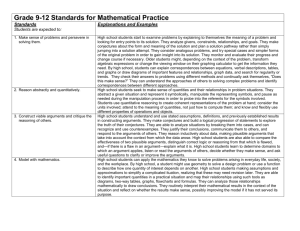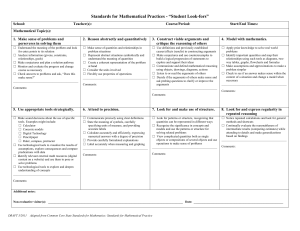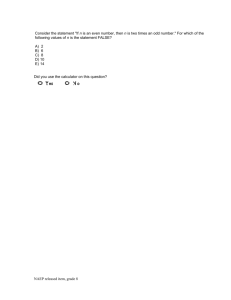Egg Drop Design Challenge Standards
advertisement

Egg Drop Design Challenge ScienceSCSH - Characteristics of Science SCSh2. Students will use standard safety practices for all classroom laboratory and field investigations. SCSh3. Students will identify and investigate problems scientifically. c. Collect, organize and record appropriate data. e. Develop reasonable conclusions based on data collected. SCSh4. Students use tools and instruments for observing, measuring, and manipulating scientific equipment and materials. a. Develop and use systematic procedures for recording and organizing information. c. Use technology to develop, test, and revise experimental or mathematical models. SCSh5. Students will demonstrate the computation and estimation skills necessary for analyzing data and developing reasonable scientific explanations. a. Trace the source on any large disparity between estimated and calculated answers to problems. b. Consider possible effects of measurement errors on calculations. c. Recognize the relationship between accuracy and precision. e. Solve scientific problems by substituting quantitative values, using dimensional analysis and/or simple algebraic formulas as appropriate. SCSh6. Students will communicate scientific investigations and information clearly. b. Write clear, coherent accounts of current scientific issues, including possible alternative interpretations of the data. SP - Physics Standards SP1. Students will analyze the relationships between force, mass, gravity, and the motion of objects. h. Determine the conditions required to maintain a body in a state of static equilibrium. SP3. Students will evaluate the forms and transformations of energy. a. Analyze, evaluate, and apply the principle of conservation of energy and measure the components of work-energy theorem by e. Demonstrate the factors required to produce a change in momentum. TechnologyAASL 21st Century Learner Standards: Inquire, think critically, and gain knowledge 1.1.1 Follow and inquiry-based process in seeking knowledge in curricular subjects, and make the real-world connection for using this process in own life. 1.1.2 Use prior and background knowledge as context for new learning. 1.1.9 Collaborate with others to broaden and deepen understanding. 1.3.4 Contribute to the exchange of ideas within the learning community. 1.3.5 Use information technology responsibly. 2.1.2 Organize knowledge so that it is useful. 2.1.4 Use technology and other information tools to analyze and organize information. 2.1.5 Collaborate with others to exchange ideas, develop new understandings, make decisions, and solve problems. 2.2.1 Demonstrate flexibility in the use of resources by adapting information strategies to each specific resource and by seeking additional resources when clear conclusions cannot be drawn. 2.2.4 Demonstrate personal productivity by completing products to express learning. 2.4.4 Develop directions for future investigations 3.1.2 Participate and collaborate as members of a social and intellectual network of learners. 3.1.3 Use writing and speaking skills to communicate new understandings effectively. 3.2.1 Demonstrate leadership and confidence by presenting ideas to others in both formal and informal situations. 3.2.3 Demonstrate teamwork by working productively with others. 3.4.3 Assess own ability to work with others in a group setting by evaluating varied roles, leadership, and demonstrations of respect for other viewpoints. Engineering- MathematicsInterpret the structure of expressions Understand solving equations as a process of reasoning and explain the reasoning Solve equations and inequalities in one variable Mathematical Practices are listed with each grade’s mathematical content standards to reflect the need to connect the mathematical practices to mathematical content in instruction. The Standards for Mathematical Practice describe varieties of expertise that mathematics educators at all levels should seek to develop in their students. 1 Make sense of problems and persevere in solving them. High school students start to examine problems by explaining to themselves the meaning of a problem and looking for entry points to its solution. They analyze givens, constraints, relationships, and goals. They make conjectures about the form and meaning of the solution and plan a solution pathway rather than simply jumping into a solution attempt. They consider analogous problems, and try special cases and simpler forms of the original problem in order to gain insight into its solution. They monitor and evaluate their progress and change course if necessary. Older students might, depending on the context of the problem, transform algebraic expressions or change the viewing window on their graphing calculator to get the information they need. By high school, students can explain correspondences between equations, verbal descriptions, tables, and graphs or draw diagrams of important features and relationships, graph data, and search for regularity or trends. They check their answers to problems using different methods and continually ask themselves, “Does this make sense?” They can understand the approaches of others to solving complex problems and identify correspondences between different approaches. 2 Reason abstractly and quantitatively. High school students seek to make sense of quantities and their relationships in problem situations. They abstract a given situation and represent it symbolically, manipulate the representing symbols, and pause as needed during the manipulation process in order to probe into the referents for the symbols involved. Students use quantitative reasoning to create coherent representations of the problem at hand; consider the units involved; attend to the meaning of quantities, not just how to compute them; and know and flexibly use different properties of operations and objects. 3 Construct viable arguments and critique the reasoning of others. High school students understand and use stated assumptions, definitions, and previously established results in constructing arguments. They make conjectures and build a logical progression of statements to explore the truth of their conjectures. They are able to analyze situations by breaking them into cases, and can recognize and use counterexamples. They justify their conclusions, communicate them to others, and respond to the arguments of others. They reason inductively about data, making plausible arguments that take into account the context from which the data arose. High school students are also able to compare the effectiveness of two plausible arguments, distinguish correct logic or reasoning from that which is flawed, and—if there is a flaw in an argument—explain what it is. High school students learn to determine domains, to which an argument applies, listen or read the arguments of others, decide whether they make sense, and ask useful questions to clarify or improve the arguments. 5 Use appropriate tools strategically. High school students consider the available tools when solving a mathematical problem. These tools might include pencil and paper, concrete models, a ruler, a protractor, a calculator, a spreadsheet, a computer algebra system, a statistical package, or dynamic geometry software. High school students should be sufficiently familiar with tools appropriate for their grade or course to make sound decisions about when each of these tools might be helpful, recognizing both the insight to be gained and their limitations. For example, high school students analyze graphs of functions and solutions generated using a graphing calculator. They detect possible errors by strategically using estimation and other mathematical knowledge. When making mathematical models, they know that technology can enable them to visualize the results of varying assumptions, explore consequences, and compare predictions with data. They are able to identify relevant external mathematical resources, such as digital content located on a website, and use them to pose or solve problems. They are able to use technological tools to explore and deepen their understanding of concepts.








